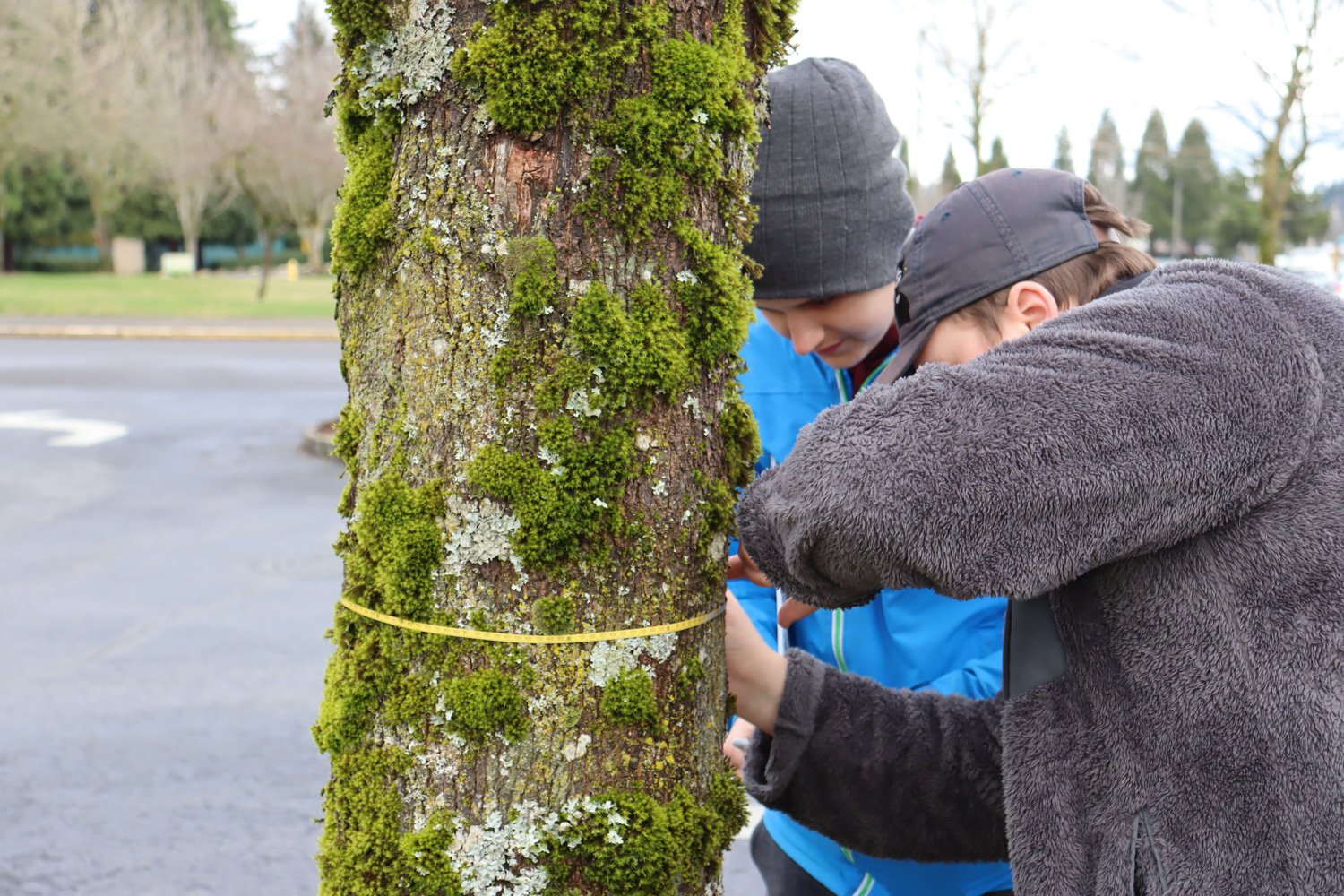Taking Climate Literacy into the Schoolyard
Introduction
Studying observable phenomena in a living schoolyard or schoolyard forest is an opportunity for teachers and students to make tangible, place-based, and engaging connections to climate literacy curricula. Students can explore the causes and impacts of climate change, along with some mitigation solutions and adaptation strategies, all in the schoolyard.
Some key topics to consider, along with lesson links by grade band, are shared below.
Climate Literacy Topics
Key topics to help frame the discussion and plan outdoor activities are outlined here. Lesson links by grade band are listed further below. Teachers will likely develop other connections as well, as appropriate to their own school, regional setting, and curriculum.
The Carbon Cycle: Understanding the carbon cycle includes a solid grasp of photosynthesis, the soil microbiome, and decomposition. A living schoolyard provides examples for deepening an understanding of these processes while also illustrating mitigation strategies such as carbon storage in trees and soil.
Temperature, Weather, and Microclimate: Living schoolyards have a variety of microclimates, depending on the kinds of surface materials and the types of natural vegetation. Investigating the urban heat island effect and these microclimates through the day and the seasons allows students to better understand the factors involved and some solutions for climate resilience.
Rainstorm Events and Stormwater Runoff: Depending on the surface materials used, a schoolyard can either contribute to rainwater infiltration and purification (by having soil and other permeable surfaces, bioswales, etc.) or can contribute to increased runoff and flooding (by using asphalt, concrete, etc.). As storm events increase in intensity and duration with climate change, students can investigate and learn about impacts of their schoolyard on their neighborhood and the local watershed.
Phenology: Students can study changes in the timing of bud, flower, and fruit set with climate change and participate in community science efforts.
Wildlife and Habitat: Documenting organisms in a living schoolyard can provide data for tracking changes in the campus and local ecosystem, including the timing of migration and hibernation and the arrival of any new pests and diseases.
Lesson Links by Grade Band
The curated collection below, organized by grade band, is part of a larger collection of outdoor, hands-on, and standards-based lessons from established leaders in the field of outdoor education. For the full collection, visit the Educator Resource Library at Green Schoolyards America.
Grades K-5
The Carbon Cycle: Trees and Climate Change, Photosynthesis Tag (PDF page 136), Shades of Green (PDF page 26), Leaf Skeletons
Temperature, Weather, and Microclimate: Cool It, Explore Sun, Shade and Shadows, How Cool Is Your Schoolyard?™, Leaf Transpiration, Pine Cone Investigation
Stormwater: Mapping a Study Site, Water on Various Surfaces
Phenology: Budburst, My Best “Bud,” Rethinking Drawing a Tree
Wildlife and Habitat: Mapping a Study Site, Who’s Been in the Forest?, Who’s Sharing Our Space?, Wildlife Inventory, Writing to Observe, Writing to Think
Grades 6-8
The Carbon Cycle: The Carbon Dioxide Game, Caught Up in the Carbon Cycle, Photosynthesis Drives Change In Atmospheric CO2 , Trees and Climate Change
Temperature, Weather, and Microclimate: Cool It, How Cool Is Your Schoolyard?™, Leaf Transpiration, Measuring Canopy Cover, Pine Cone Investigation, Solar Energy and Soil Temperature
Stormwater: Follow the Drop, Soil Infiltration Tests
Phenology: Budburst, My Best “Bud,” Twigs: Field Investigations, Rethinking Drawing a Tree
Wildlife and Habitat: Leaf Litter Ecology Lab, Mapping a Study Site, Who’s Been in the Forest?, Who’s Sharing Our Space?, Wildlife Inventory, Writing to Observe, Writing to Think
Grades 9-12
The Carbon Cycle: The Carbon Dioxide Game, Caught Up in the Carbon Cycle, Photosynthesis Drives Change In Atmospheric CO2, Trees and Climate Change
Temperature, Weather, and Microclimate: How Cool Is Your Schoolyard?™, Leaf Transpiration, Moisture Makers, Measuring Canopy Cover, Pine Cone Investigation, Solar Energy and Soil Temperature, Water from Trees
Phenology: Budburst, Twigs: Field Investigations, Rethinking Drawing a Tree
Stormwater: Follow the Drop, Soil Infiltration Tests
Wildlife and Habitat: Litter Critters, Mapping a Study Site, Schoolyard Biodiversity, Who’s Sharing Our Space?, Wildlife Inventory, Writing to Observe, Writing to Think
Additional Resources
MIT. Climate Portal Explainer. (n.d.). Mitigation and Adaptation. https://climate.mit.edu/explainers/mitigation-and-adaptation
Made Clear (Maryland and Delaware Climate Change Education Assessment and Research). Climate Change in the Next Generation Science Standards. (2013). https://www.climateedresearch.org/publications/2013/Climate-Change-NGSS.pdf
North American Association for Environmental Education. (2024). Guidelines for Excellence: Educating for Climate Action and Justice. https://eepro.naaee.org/sites/default/files/2024-09/Guidelines-%237-Educating-for-Climate-Action-and-Justice-Accessible_0.pdf
SubjectToClimate. Teaching Materials. https://subjecttoclimate.org/external-resources
U.S. Global Change Research Program. (2024). Climate Literacy: Essential Principles for Understanding and Addressing Climate Change. https://drive.google.com/file/d/1hfNCbD4uPlfsPGrMCDZEHImtvL_dBRNM/view
Schoolyard Forest System℠
The Schoolyard Forest System℠ Resource Library is a set of practical tools for schools and districts working to increase tree canopy on public school grounds to shade and protect pre-K-12 students from extreme heat and rising temperatures due to climate change. Funding for the first phase of this initiative was provided by a grant administered by the California Department of Forestry and Fire Protection (CAL FIRE) Urban and Community Forestry Program, and private philanthropy.




